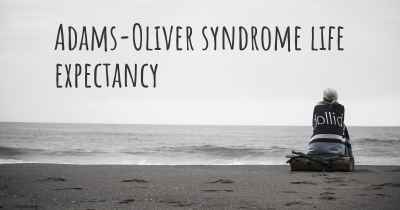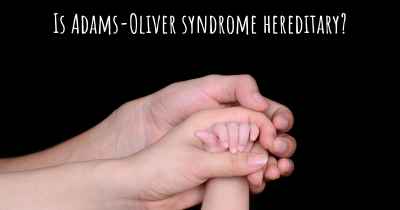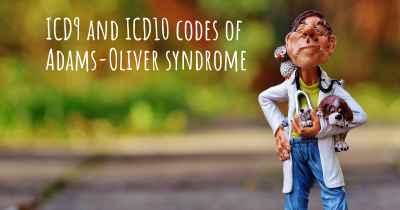Which are the symptoms of Adams-Oliver syndrome?
See the worst symptoms of affected by Adams-Oliver syndrome here

Adams-Oliver Syndrome: Symptoms and Characteristics
Adams-Oliver Syndrome (AOS) is a rare genetic disorder that primarily affects the skin, limbs, and cardiovascular system. It is characterized by a combination of specific physical abnormalities, which can vary in severity and presentation from person to person. The syndrome is named after the two physicians who first described it in the medical literature, Robert Adams and William Oliver, in the early 1940s.
Skin Abnormalities
One of the hallmark features of Adams-Oliver Syndrome is the presence of cutis aplasia, which refers to missing patches of skin, typically on the scalp. These areas of skin may appear as shallow depressions or larger, more significant defects. In some cases, the scalp defects may be covered by thin, transparent membranes. Additionally, individuals with AOS may have cutis marmorata, a condition characterized by a mottled or marbled appearance of the skin due to abnormal blood vessel dilation.
Limb Abnormalities
AOS often involves limb abnormalities, which can affect both the upper and lower extremities. These abnormalities may include missing fingers or toes (known as brachydactyly), partial or complete absence of fingers or toes (known as ectrodactyly), or fusion of fingers or toes (known as syndactyly). The severity of limb involvement can vary widely, ranging from mild to severe.
Cardiovascular Abnormalities
Individuals with Adams-Oliver Syndrome may also exhibit cardiovascular abnormalities. These can include congenital heart defects such as ventricular septal defects (VSD), atrial septal defects (ASD), or tetralogy of Fallot. These heart defects can lead to abnormal blood flow and may require medical intervention.
Other Associated Features
In addition to the primary characteristics mentioned above, Adams-Oliver Syndrome may be associated with several other features, although they are not always present in every individual:
- Intellectual disability: Some individuals with AOS may have developmental delays or intellectual disabilities, although the majority have normal intelligence.
- Eye abnormalities: Certain eye abnormalities, such as coloboma (a gap or hole in one of the structures of the eye) or microphthalmia (abnormally small eyes), have been reported in some cases.
- Skull and brain abnormalities: Some individuals may have craniosynostosis, a condition where the bones of the skull fuse prematurely, leading to an abnormal head shape. Additionally, brain abnormalities such as agenesis of the corpus callosum (partial or complete absence of the structure connecting the two hemispheres of the brain) have been observed in a small number of cases.
- Genitourinary abnormalities: Rarely, individuals with AOS may have genitourinary abnormalities such as hypospadias (abnormal positioning of the urethral opening in males) or renal anomalies (abnormalities of the kidneys).
Genetic Causes
Adams-Oliver Syndrome is primarily caused by mutations in several genes, including ARHGAP31, DOCK6, NOTCH1, and RBPJ. These genes play important roles in the development and maintenance of the skin, limbs, and cardiovascular system. The inheritance pattern of AOS can vary, with some cases being inherited in an autosomal dominant manner, while others occur sporadically as de novo mutations.
Diagnosis and Management
Diagnosing Adams-Oliver Syndrome typically involves a thorough clinical evaluation, including a detailed examination of the skin, limbs, and cardiovascular system. Genetic testing may be recommended to confirm the diagnosis and identify the specific gene mutation involved. Additionally, imaging studies such as echocardiography and brain MRI may be performed to assess associated abnormalities.
Management of Adams-Oliver Syndrome is typically focused on addressing the specific symptoms and complications present in each individual. This may involve surgical interventions to correct limb abnormalities or congenital heart defects. Regular monitoring and follow-up with a multidisciplinary team of specialists, including dermatologists, geneticists, cardiologists, and orthopedic surgeons, is essential to ensure appropriate care and support.
Conclusion
Adams-Oliver Syndrome is a rare genetic disorder characterized by skin, limb, and cardiovascular abnormalities. The syndrome's distinct features, including cutis aplasia, limb anomalies, and heart defects, can vary in severity and presentation. Genetic mutations in specific genes are responsible for the syndrome's development. Early diagnosis, comprehensive medical evaluation, and appropriate management are crucial in providing optimal care for individuals with Adams-Oliver Syndrome.
Posted May 10, 2017 by Garrett 1000
Head- has a bald spot & can have thin skin on skull. Also, has a big fontanal.
Hands- has or doesn’t have any fingers or hands.
Feet- same as hands.
Heart- usually a vsd defect or pda murmur. Might require surgery.
Posted Aug 16, 2019 by Amanda 3000
Aplasia cutis congenita
Posted Mar 4, 2022 by Trudy, Steph's mum 2650








